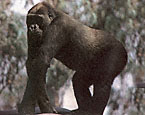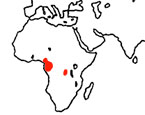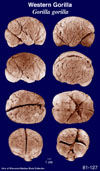|
Western
Gorilla
(Gorilla gorilla) #81-127 |
||||
|
|
Physical
characteristics and distribution
|
|
The
single species G. gorilla stands 1.25 to 1.75 meters
on two feet. Actual height is a bit more, as G. gorilla
stands with the legs slightly bent at the knees. There is no
tail. The armspan exceeds standing height measuring between
2 and 2.75 meters. The chest can be up to 508 mm across with
a circumference for adult males between 1.25 and 1.75 meters.
Weights for adult females range from 70-140 kg. and 135-275
kg. for adult males. G. gorilla has bare face, ears,
hands, and feet, as well as the chest of old males. There are
color variations between subspecies: G. g beringei and
G. g graueri both have black skin and hair, adult males
developing a silvery saddle across the back between the shoulders
and rump. G. g beringie can be distinguished by its longer,
silkier fur, especially on the arms. G. g gorilla is
more brownish or grayish and the male’s silvery saddle
extends to the thighs and blends into the body color more. |
|
Description
of the brain
|
|
Animal
source and preparation
|
|
All
specimens collected followed the same preparation
and histological procedure.
|
Other Related Resources (websites and publications)
List of Specimens | Explore Collections | Brain Sections | Brain Evolution | Brain Development | Brain Circuitry | Brain Functions | Location and Use | Related Web Sites | Contact Us | Search MSU Database | Personnel | Home



